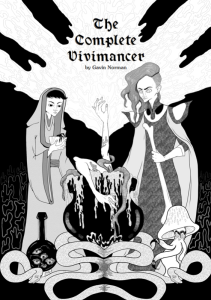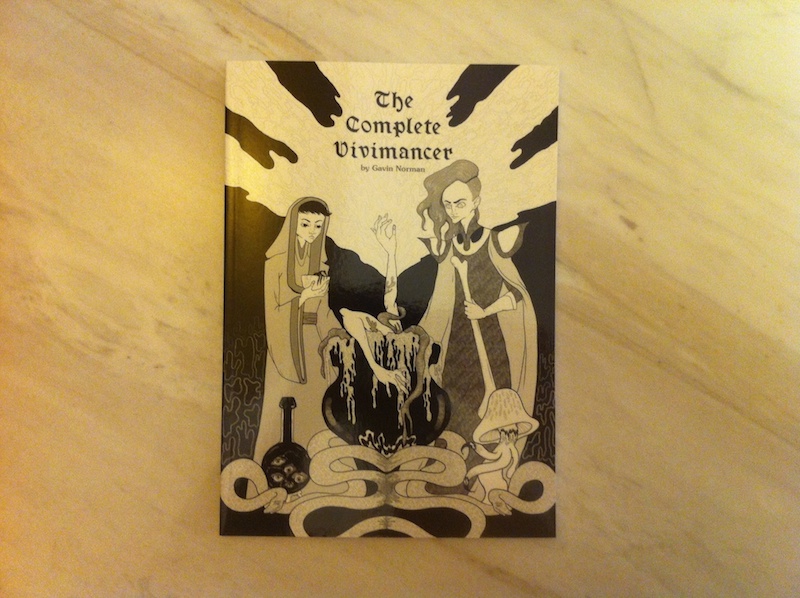 Gavin N., author of the City of Iron blog and the previous Labyrinth Lord supplement Theorems & Thaumaturgy, has released another book, the Complete Vivimancer. T&T is something of an OSR Tome of Magic, introducing several new specialist magic-user variants and a host of new spells and magic items. I previously reviewed it (and the PDF is free, so you really have no excuse not to check it out). The Complete Vivimancer takes the eponymous class introduced in T&T and expands it further.
Gavin N., author of the City of Iron blog and the previous Labyrinth Lord supplement Theorems & Thaumaturgy, has released another book, the Complete Vivimancer. T&T is something of an OSR Tome of Magic, introducing several new specialist magic-user variants and a host of new spells and magic items. I previously reviewed it (and the PDF is free, so you really have no excuse not to check it out). The Complete Vivimancer takes the eponymous class introduced in T&T and expands it further.
Unlike T&T, the CV has an A5 layout, which I much prefer. As a PDF, the size is perfect for tablets without needing to resize. Beyond the size, the layout style feels improved as well. Details like duration are offset from descriptive text when needed, but no strict format is used, which is appreciated (including useless null info like magic resistance: none rather than just leaving it out is something that bothers me in many RPG layouts). The art is suitably weird and of a particular, consistent style. There are many worms, veins, pustules, and so forth. Breeding and reproduction are (as you might expect) constant themes. Total content is around 80 digest sized pages with periodic illustrations.
In an effort to serve as an all-in-one reference, the Complete Vivimancer repeats the relevant content from T&T alongside the new material. I can imagine this might bother some folks, but it seems appropriate to the project, and in any case there is a lot of new content as well. Interestingly, a number of spells from core Labyrinth Lord are included also, but subtly adjusted to add a vivimantic flavor, which is a nice touch. For example, the vivimancer version of jump notes that the subject’s legs develop a springing capability similar to that of a cricket, which I would probably run with and rule to be an actual insectoid transformation. Depending on how seriously a given referee takes the re-skinned details, this could dramatically alter how some spells work (as it should).
That said, what exactly is included? First, the details of the class, which look at a glance to be identical to the standard magic-user (d4 HD, only daggers, no armor, create new spells and magic items at 9th level, etc). There are some guidelines about the cost of maintaining a laboratory and keeping experimental subjects, which are required for some vivimantic spells. The spell list itself is impressively large, with 30 spells each for levels 1 through 3, 20 spells for level 4, and 12 spells for each level thereafter. A slightly more restricted list of spells (12 per level) is also provided for referees to prefer a slightly more restrained spell list.
What are the spells like? Symbiotic familiar causes a plant- of fungal-based familiar to grow in or on the magic-user’s body. Anthropomorphism allows the magic-user to impart humanlike consciousness and tool using ability to an animal. Leech blast is an area effect spell that covers enemies in a mass of bloodsucking worms if a save is failed, doing continuous damage. The chimera spells are a take on monster summoning, with randomly determined qualities, and look like they would be fun in play. Detach makes a body part separate from its owner, though remaining under his or her control (allowing crawling hands and so forth). Lockroaches are a living magic item that functions sort of like a knock scroll (I bet you can guess how they work). While a large number of vivimantic effects are permanent, allowing, for example, a given vivimancer to over time create a horde of fungal zombies, importantly (as far as I can tell) vivimancers do not have any special influence over most creations, requiring intelligent and creative play.
How specialist magic-users interact with the advancement systems of a campaign is somewhat complicated. How do magic-users learn new spells? Must they find new spells through adventuring, as suggested by Labyrinth Lord page 19, or do they automatically add one or two new spells upon level-up? This is tricky because it interacts with the system that the referee uses for awarding treasure. If you are following the LL rules strictly, magic-users are not able to research new spells until 9th level. Personally, I think this approach has some shortcomings, as few games last until 9th level. It is mentioned on page 72 that one might want to relax this rule, but guidelines beyond that are not given. Some house rules or treasure placement fudging are likely required to make sure that vivimancer characters are able to acquire sufficient new spells.
In addition to the spells and magic items, which make up the bulk of the CV, there is a one page appendix of psionic powers which looks perfectly serviceable and a random table based mutation system. Like Gavin’s other work, the CV is thoughtfully written and carefully constructed. The LL chassis that it sits upon is widely compatible with traditional fantasy games, making it easy to incorporate spells and magic items into a given campaign even if you don’t use the class itself, though the vivimancer archetype might also be well served by some more innovative rules. That said, I understand the design decision to remain close to the original magic-user. As with T&T, the entire work other than the name is open game content, making it easy to include spells or other content that you like within your own OGL-licensed products. Overall, I think I would enjoy playing a vivimancer myself, which seems like a good bottom line assessment.

